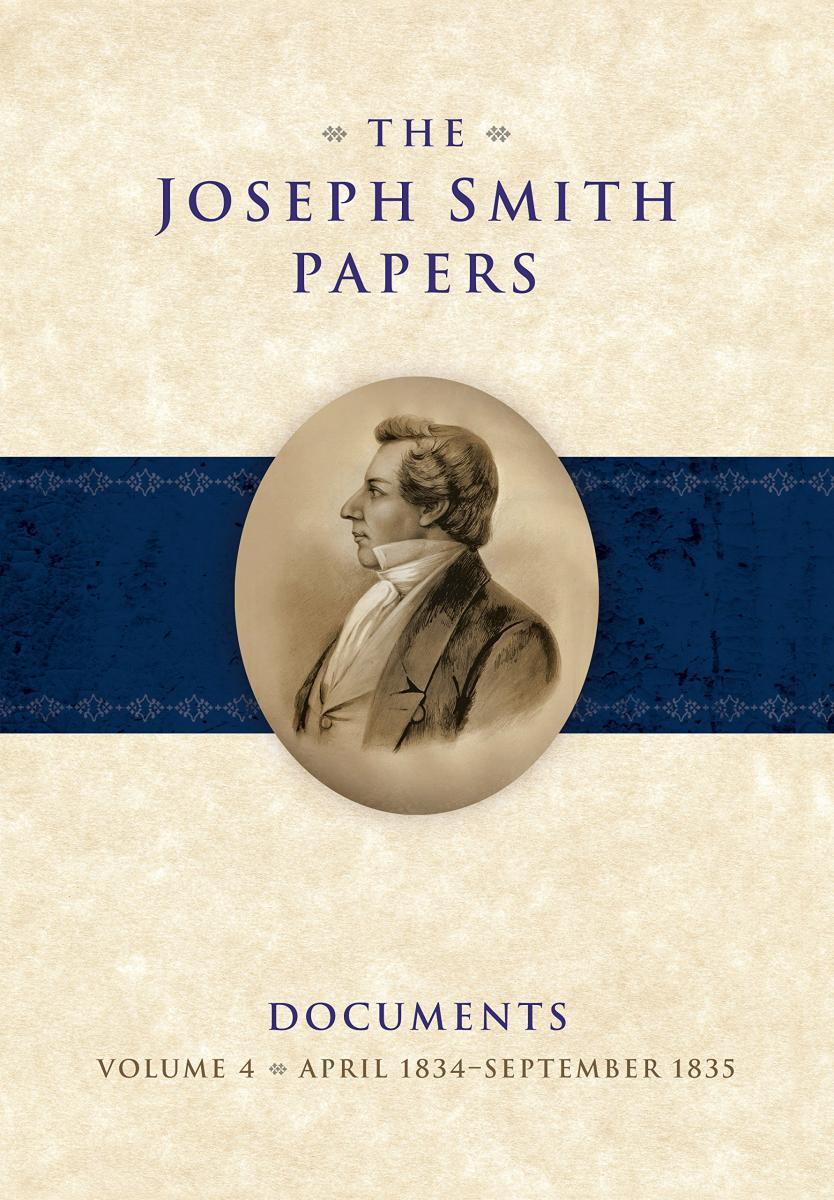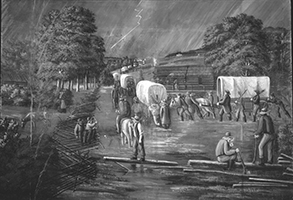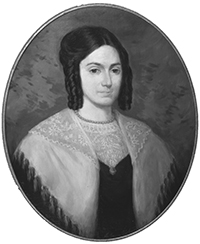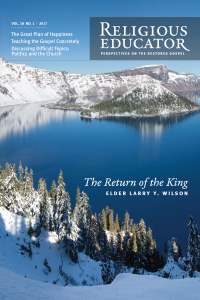Review of Documents, Volume 4: April 1834–September 1835
J. Stuart
J. Stuart, "Review of Documents, Volume 4: April 1834–September 1835," Religious Educator 18, no. 1 (2017): 124–9.
J. Stuart (jstubyu@gmail.com) was a PhD student in history at the University of Utah when this article was published.
 Godfrey, Matthew C., Brenden W. Rensink, Alex D. Smith, Max H Parkin, and Alexander L. Baugh, eds. Documents, Volume 4: April 1834–September 1835. Vol. 4 of the Documents series of The Joseph Smith Papers, edited by Ronald K. Esplin and Matthew J. Grow. Salt Lake City: Church Historian’s Press, 2016. ix, 668 pp. Photographs, maps, notes, bibliography, appendices, index. ISBN 978-1629721743,us $54.95.
Godfrey, Matthew C., Brenden W. Rensink, Alex D. Smith, Max H Parkin, and Alexander L. Baugh, eds. Documents, Volume 4: April 1834–September 1835. Vol. 4 of the Documents series of The Joseph Smith Papers, edited by Ronald K. Esplin and Matthew J. Grow. Salt Lake City: Church Historian’s Press, 2016. ix, 668 pp. Photographs, maps, notes, bibliography, appendices, index. ISBN 978-1629721743,us $54.95.
The Joseph Smith Papers Project has revolutionized the way that historians and educators can study and teach the life of the LDS Church’s first prophet. The fourth volume of the Documents series provides introductions and transcripts of its documents to help readers better understand each source. Documents, Volume 4 contains several important documents produced between April 1834–September 1835, including a sales receipt for the purchase of Egyptian artifacts that included the Book of Abraham, early documents related to the publication of the Book of Commandments (Doctrine and Covenants), and the promise of an endowment of power in the Kirtland Temple. Although Documents, Volume 4 has fewer revelations than the first three volumes of the Documents series, that should not prevent historians and researchers from engaging with the volume for research and classroom use.
Some documents are more valuable than others for specific lessons and approaches to teaching Church history and the Doctrine and Covenants (every person’s teaching approach can benefit by including material from Documents, Volume 4). With this in mind, throughout this review I articulate several key areas of the volume that educators can use to employ the documents in their gospel teaching. Specifically, I suggest ways that teachers can better explain the pragmatic aspects of Joseph Smith’s prophetic leadership, the importance of the Camp of Israel (also known as Zion’s Camp), and how the Camp of Israel prepared Latter-day Saints for callings within the early Church.
Throughout 1834–35, Joseph Smith engaged in many Church-related duties that we do not traditionally emphasize in Sunday School, seminary, or institute classes. Documents, Volume 4 presents readers with several dozen documents related to the ways that Joseph Smith and others governed the early Church. These documents will help students to see the ways that Joseph Smith and other priesthood leaders collaborated on matters both practical and spiritual. For instance, some High Council meetings address matters of Church discipline, some relate to raising volunteers for the Camp of Israel, and others give specific direction to Church members in their callings. These types of meetings reveal the ways that early Church leaders made decisions and operated, providing a glimpse into the decision-making processes that we need our students to learn in order to serve in their own callings. They also highlight the “busyness” of Joseph Smith’s life. He participated in scores of meetings, corresponded with many people, preached, led the Church through financial struggles, and oversaw the publication and spread of his teachings. Using these documents, teachers can help their students recognize the weight of Joseph Smith’s day-to-day duties as they help their audience understand his religious teachings.
Documents, Volume 4 also contains letters written to Emma Smith that shed light on the familial responsibilities that Joseph did his best to tend to while doing all that he could to lead the Church (48–59). These documents portray a very human side to Joseph, a valuable counterbalance to hagiographic narratives that downplay the parts of the Prophet’s life not directly related to Church governance or doctrine. These sources also allow educators to introduce students to the Smiths’ marital relationship, which faced the highs and lows that every marriage faces (with the additional stresses of Joseph’s frequent absence on Church business). Joseph Smith spent a lot of time doing things other than receiving revelations or pondering the topic of his next sermon. Like Latter-day Saints today, he balanced family responsibilities and other concerns outside of Church governance.
 Why did the Saints march to Zion despite their failure to recover their land and property?
Why did the Saints march to Zion despite their failure to recover their land and property?
Even within his Church responsibilities, Joseph Smith grappled with leading the Saints through events like the Camp of Israel. The sources in Documents, Volume 4 remind readers that Joseph Smith was not perfect, nor did he operate in ideal conditions. He argued with his fellow Saints over petty matters like the presence of a dog in the camp. Cholera swept through the camp, and more than a dozen participants passed away as a result. However, the Camp of Israel’s failure to win back Jackson County through military means reveals important traits of Mormonism’s first prophet. Joseph Smith possessed the humility to disband the camp even though it went against what he wanted to do personally. The Camp of Israel demonstrates how Joseph Smith received “refined” revelation when the Saints’ circumstances required.
Documents, Volume 4 also invites readers to consider why the Lord would ask the Saints to march to Zion despite their failure to recover their land and property. Teachers could ask students to consider that many of those who accepted both the revelation to redeem Zion as well as the Lord’s instruction to disband the Camp of Israel became leaders of the Church in Ohio, Missouri, Illinois, and elsewhere. In fact, Joseph Smith specifically said that the Camp of Israel proved the Apostles’ faithfulness and capacity for leadership (221; see 219–34 for more on the calling of the Quorum of the Twelve Apostles). Educators could organize a lesson around the idea that Latter-day Saints have always had to serve in the face of frustration and disappointment—and why those who persevere in times of trouble (a trait belonging to model disciples) might be seen as especially ready to lead other Saints.
Sources in Documents, Volume 4 also help to explain the expansion of priesthood quorums and the evolution of Church government from April 1834–April 1835. Using letters, meeting minutes, revelations, and other documents available in this volume of The Joseph Smith Papers will undoubtedly help teachers to better answer student questions about priesthood organization and the evolving responsibilities of Church leaders. Teachers can use the meeting minutes, letters, and revelations in Documents, Volume 4 to discuss the practical reasons why the early Church’s governing structures changed. Joseph Smith could not manage the minutiae of everyday Church governance without help; the Lord provided other leaders to assist in leading a Church experiencing rapid growth.
 Documents, Volume 4 also contains letters written to Emma Smith that shed light on how Joseph did his best tending to his familial responsibilities while leading the Church.
Documents, Volume 4 also contains letters written to Emma Smith that shed light on how Joseph did his best tending to his familial responsibilities while leading the Church.
Educators should also be sure to teach their students about the participation of women and children in the Camp of Israel. While teaching about the importance of women’s contributions, educators should point out that a woman, Jane Clark, gave the second-largest financial donation to the Camp of Israel—fifty dollars (148). Unfortunately, because of record-keeping practices in the nineteenth century, we know much less about female participation in the early Church than male participation. As educators, we can do much more to teach the history of women in Mormonism—this document provides a great opportunity to include their faithful actions.
The sources in Documents, Volume 4 reveal the ways that Joseph led the early Saints and how the Lord proved the faithfulness of many early leaders of the Church. The documents also provide material that educators can use to teach about Joseph Smith’s personal life and the ways that it affected his Church duties. Teachers can and will glean important information for teaching Church history and the Doctrine and Covenants from Documents, Volume 4. I wholeheartedly recommend that teachers use the documents from the Joseph Smith Papers Project to add variety and detail to their lessons and to increase their own gospel knowledge.
